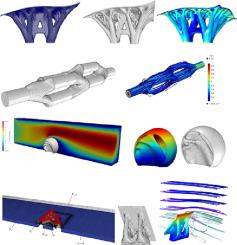Applied Mathematical Modelling ( IF 4.4 ) Pub Date : 2021-09-04 , DOI: 10.1016/j.apm.2021.08.021 Hao Li 1 , Tsuguo Kondoh 1 , Pierre Jolivet 2 , Kozo Furuta 1 , Takayuki Yamada 3 , Benliang Zhu 1, 4 , Kazuhiro Izui 1 , Shinji Nishiwaki 1

|
We propose a new framework for the two- and three-dimensional topology optimization (TO) of the weakly-coupled fluid–structure system. The proposed design methodology uses a reaction–diffusion equation (RDE) for updating the level-set function based on the topological sensitivity. From the numerical point of view, two key ingredients are highlighted: (i) the body-fitted adaptive mesh strategy allows the disjoint reunion of a global mesh that contains several (fluid/solid) subdomains, whose interfaces can be described by an implicitly defined surface (zero level-set); (ii) our framework uses FreeFEM for finite element analysis (FEA) and PETSc for distributed linear algebra. Efficient preconditioner techniques are utilized to solve the large-scale finite element systems. From the engineering stand point, we propose a complete product development workflow including the pre-processing, TO, B-Rep conversion, and the numerical experiment. The performance of our methodology is demonstrated by solving three different optimization problems: compliance, power dissipation, and fluid–structure interaction (FSI). For comparison and for assessing our various techniques, we benchmark our designs against state-of-the-art works followed by showcasing a variety of practical engineering design examples.
中文翻译:

基于水平集方法的贴体网格自适应流固系统三维拓扑优化
我们为弱耦合流固系统的二维和三维拓扑优化 (TO) 提出了一个新框架。所提出的设计方法使用反应扩散方程 (RDE) 来更新基于拓扑灵敏度的水平集函数。从数值的角度来看,突出显示了两个关键要素:(i) 贴体自适应网格策略允许包含多个(流体/固体)子域的全局网格的不相交重聚,其界面可以通过隐式定义表面(零水平集);(ii) 我们的框架使用 FreeFEM 进行有限元分析 (FEA),使用 PETSc 进行分布式线性代数。有效的预处理器技术被用来解决大型有限元系统。从工程的角度来看,我们提出了完整的产品开发工作流程,包括预处理、TO、B-Rep 转换和数值实验。我们的方法的性能通过解决三个不同的优化问题来证明:顺应性、功率耗散和流固耦合 (FSI)。为了比较和评估我们的各种技术,我们将我们的设计与最先进的作品进行了对比,然后展示了各种实际的工程设计示例。











































 京公网安备 11010802027423号
京公网安备 11010802027423号